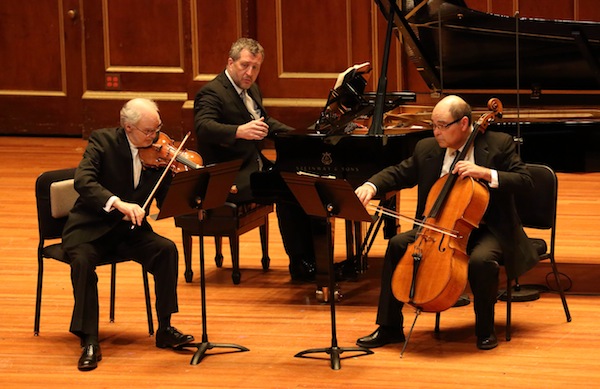Adès, Boston Symphony Chamber Players make music like old friends in congenial program

Thomas Adès performed Schubert’s “Notturno” with concertmaster Malcolm Lowe and cellist Sato Knudsen in the Boston Symphony Chamber Players concert Sunday afternoon at Jordan Hall. Photo: Hilary Scott
Last year, the Boston Symphony Orchestra entered into its first-ever artistic partnership with prominent British composer and conductor Thomas Adès. The relationship has been rewarding all around. With the orchestra, Adès led a mesmerizing account of his own Totentanz in the fall of 2016. This week, he will conduct the BSO in Ligeti’s Violin Concerto, which will spotlight the superb young violinist Augustin Hadelich.
But Adès is also a fine pianist, and he has been drawn to smaller works in intimate performances. With tenor Ian Bostridge in 2016, he traversed Franz Schubert’s Winterreise with an accompaniment that conjured the cycle’s rich poetic imagery. His keen musicianship was on display again Sunday afternoon at Jordan Hall, when he was welcomed by the Boston Symphony Chamber Players for a concert of music by Schubert, Leoš Janáček, György Ligeti and Anton Reicha.
Adès’ piano technique is formidable, but his deeply expressive playing makes his performances such a joy to hear. In Janáček’s Concertino for piano, winds, and strings, he conjured bold and colorful phrases from the keyboard. The piece’s four movements had driving intensity, and Adès rendered its passages with stark power and energy. In the soft sections of the first movement, his lines seemed to glow like faint light.
The ensemble writing in the Concertino relies primarily on coloristic effects which were ably reproduced on Sunday. James Sommerville’s French horn supplied warm phrases in answer to Adès’ playing in the first movement. William R. Hudgins’ clarinet line in the second had a sly humor. The strings — Malcolm Lowe, Haldan Martinson and Steven Ansell — etched sharp accents for a biting and energetic conclusion.
In Schubert’s Notturno in E-flat, scored for piano trio, Adès’ performance resounded with a pearly depth. His phrases had an unmistakably vocal arc as well as tasteful rubato shading in lines that shimmered like moonlight on water. If only the accompaniment by violinist Lowe and cellist Sato Knudsen, regrettably two-dimensional in this short but expressive piece, had matched Adès’ beautiful, colorful playing.
Two pieces for wind quintet rounded out the program. Ligeti’s Six Bagatelles (which first came into being as a set of piano miniatures entitled Musica ricercata) brimmed with a live-wire electricity that recalled Béla Bartók and Igor Stravinsky. The Chamber Players sounded attuned to the orchestration’s subtleties, their dynamic shading both wide-ranging and precise. In the second Bagatelle, Sommerville’s blistering horn call faded into the ensemble’s softly played major triad, and a pristine folk-like melody floated elegantly over a rollicking bass line performed deftly by bassoonist Richard Svoboda. The full ensemble handled the bristly, percussive rhythms of the fourth Bagatelle adroitly, while the bird calls of the fifth came to resemble eerie passages in the middle movement of Bartók’s Music for Strings, Percussion, and Celesta.
Fine playing also characterized the afternoon’s opener, Reicha’s Wind Quintet in E-flat, Op. 88, No. 2. Reicha’s two-dozen quintets solidified the wind ensemble as a prominent vehicle for chamber music. Sunday’s performance of this delightful score demonstrated why.
The writing bears both the humor of Joseph Haydn and the edgy texture of Beethoven. Yet in Sunday’s reading the elegance tying the four movements together called most to mind Wolfgang Amadeus Mozart. The outer movements featured trickling lines and textures that changed colors on a dime. The Minuet burbled like a brook, with the stately Trio providing a fine counterbalance. The third movement flowed like an aria, oboist John Ferrillo trading a beautifully sculpted line with the other players in a veritable conversation among friends.
The Boston Symphony Chamber Players with the Gewandhaus-Quartett perform Ligeti, Foss and Mendelssohn 3 p.m.February 11 at Symphony Hall. bso.org; 888-266-1200
Posted in Performances



